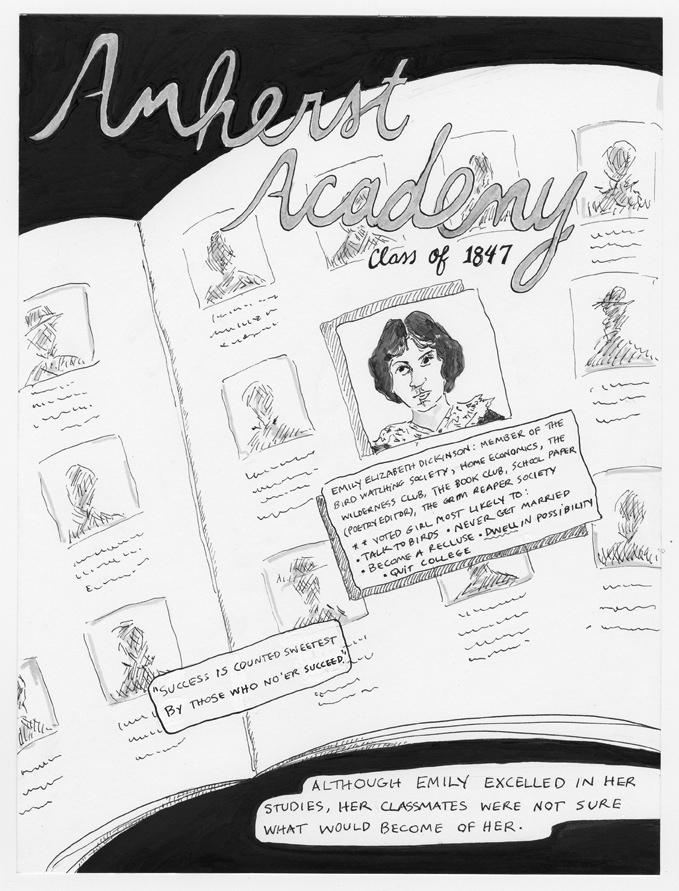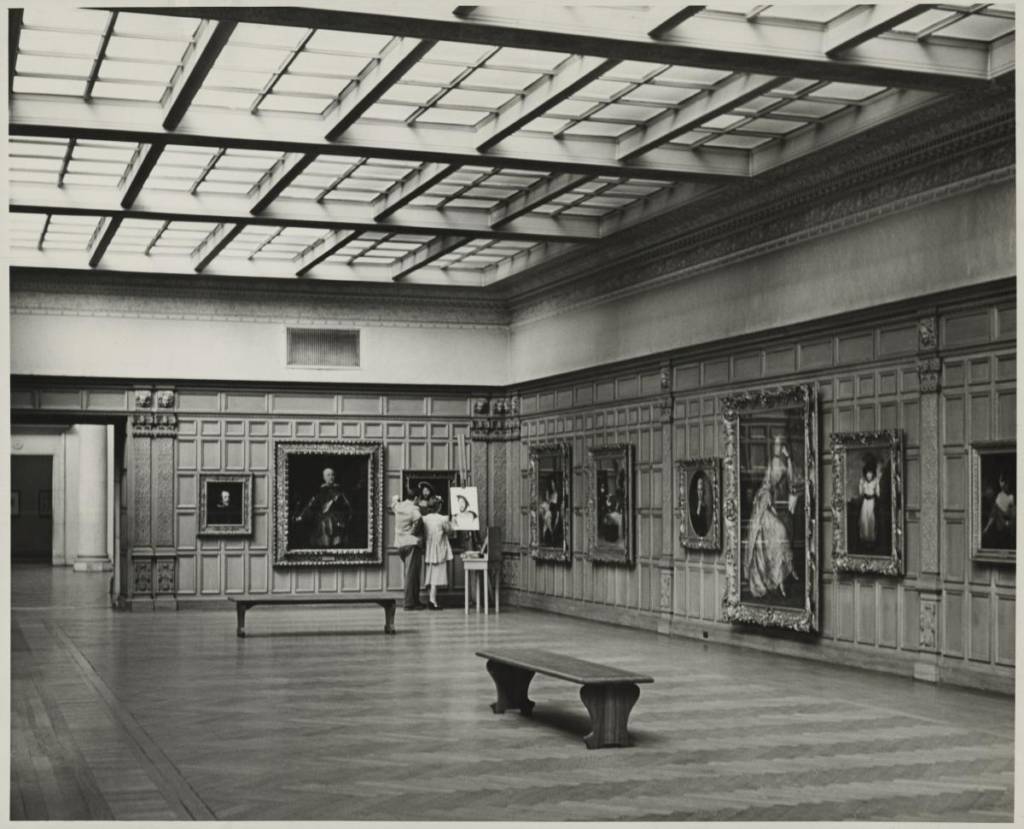By TEJU COLE
She wrote: color is the sound an object makes in response to light. Objects don’t speak unless spoken to. An object does not have a color—it makes a color (the way a bell makes a sound).
By TEJU COLE
She wrote: color is the sound an object makes in response to light. Objects don’t speak unless spoken to. An object does not have a color—it makes a color (the way a bell makes a sound).
April is POETRY MONTH, and we’re kicking it off with a satirical cartoon of local poet Emily Dickinson: girl voted most likely to dwell in possibility…
Get into the spirit of POETRY MONTH with this satirical cartoon of Emily Dickinson, who reminds us to be wary when travelling…

Rosanna Bruno is a visual artist who lives and works in Brooklyn, NY.
By BRIAN SHOLIS
In a photograph Robert Adams took northeast of Riverside, California, in 1982, serpentine paths lead toward the horizon line; it’s not easy to discern whether these are creeks, dirt trails, or roads. Human presence takes the form of wooden poles carrying electric wires, which stride diagonally from the bottom left of the composition toward the distance at right.
By BRIAN SHOLIS
In a photograph Robert Adams took northeast of Riverside, California, in 1982, serpentine paths lead toward the horizon line; it’s not easy to discern whether these are creeks, dirt trails, or roads. Human presence takes the form of wooden poles carrying electric wires, which stride diagonally from the bottom left of the composition toward the distance at right. Scrubby brush covers the low hill that spreads out beneath Adams’s camera, a few trees poke up disconsolately here and there, and a larger hill dominates the right-hand edge of the picture. In the distance is the radiance of an invisible sun, an onrushing whiteness that presses toward the camera and blots out the landscape’s details.
“Hell, there are no rules here—we’re trying
to accomplish something.”
—thomas edison
i
there were seventeen witnesses for the first execution of a human being by electrocution. William Kemmler, a sometime peddler of produce and a heavy drinker, was sentenced to death on March 29, 1889, for killing his common-law wife, Matilda Ziegler, with a hatchet. There are few details about Kemmler or his life. Born in Philadelphia but raised in Buffalo, he was said to be slender, with brown hair tending toward black. We know his parents were alcoholic immigrants from Germany. He could speak both German and English but couldn’t read a word. We also know that his father was a butcher who died after a cut he received in a drunken brawl became infected. His mother died less accidentally from alcoholism.
Work by MARTHA WILLETTE LEWIS, Curated by JEFF BERGMAN
Our relationship with maps has changed drastically in the last ten years, from the pinpoint ease of Google Maps to global positioning systems rendering us a blinking blue beacon on a grid of streets. Rarely are we explorers in the completed cartography of our planet. Visual artist Martha Willette Lewis has given us new, unreal spaces to explore by combining diagrammatic drawings, biological systems, and topographical forms. These spaces manifest as works on paper that are often folded, crumpled, or bisected. Lewis takes visual cues from systems that are usually not in contact and, in doing so, creates a skewed sense of reality. Hers is a hybridized vision shared by artists and technological innovators. The paper and drawing are real, but the vision is of an impossible place.
By ESTHER BELL

I am a sixth-generation Texan who married a fiercely native New Yorker, which means I have a keen appreciation for the ways in which places shape lives. When I moved to Cincinnati, Ohio, in the dead of winter last year, it was an odyssey that once again challenged my sense of identity. Cincinnati is worlds apart from both Texas and New York, and unlike those proudly parochial states, this city can lay a strong claim as the heart of America. It was settled in 1788 on the banks of the Ohio River, and at the turn of the century, Henry Wadsworth Longfellow named it “the Queen of the West”:
In collaboration with Lateral Office
Introduction by Scott Geiger
The Faroe Islands are not the rural, subarctic archipelago you imagine. Like their distant peers on the Danish mainland, the Faroese are thoughtful, progressive city-builders. To connect their dispersed communities, their highway system tunnels through basaltic mountains and under North Atlantic waters. Fast ferries and helicopter taxis run between remote points. With such transit infrastructure, this might seem like a maritime metropolis, if only they had the population. But more people live in Portland, Maine, than on the eighteen Faroe Islands.
At the threshold of summer, the sunglasses are on. Running in blue-sky mode, I’ve been talking up some ideas for multiplying the writing workshop times the architecture studio. Their product would be a format for storytelling across media, an alignment of complimentary strengths really well suited to engage the built environment.
By KATE MCLEAN
Introduction by AMY SANDE-FRIENDMAN
Scents conjure up times, people, and places distant from the here and now. At the heart of Kate McLean’s Sensory Maps is the power of aromas, their ability to trigger and concretize emotion and memory. McLean, born and raised in Britain, was inspired by the idea that we form our experience of place through sensory perception. She has researched, recreated, and charted the dominant scents of several cities to paint urban portraits through smell. This ongoing cartographic project is partially intended as a corrective in a world that strongly favors visual and aural information. Through capturing and diagramming the defining smells of a place, McLean tells a city’s history and describes its character. Like postcards and souvenirs, the heightened awareness of scent can enhance a visitor’s memories; for the residents of a community, local scents are signifiers of history and identity.